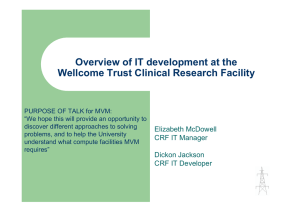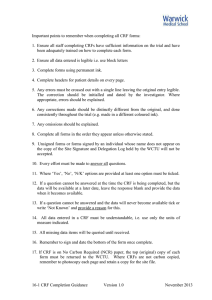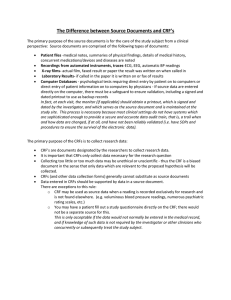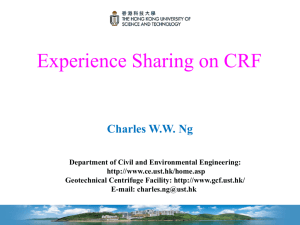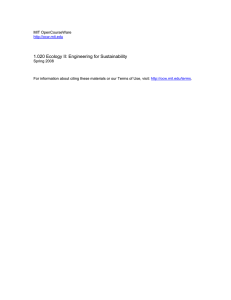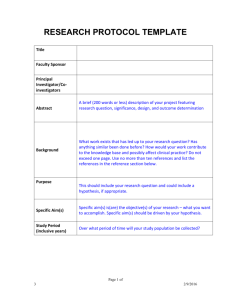Risk Event and Probability Extraction for Modeling Medical Risks
advertisement
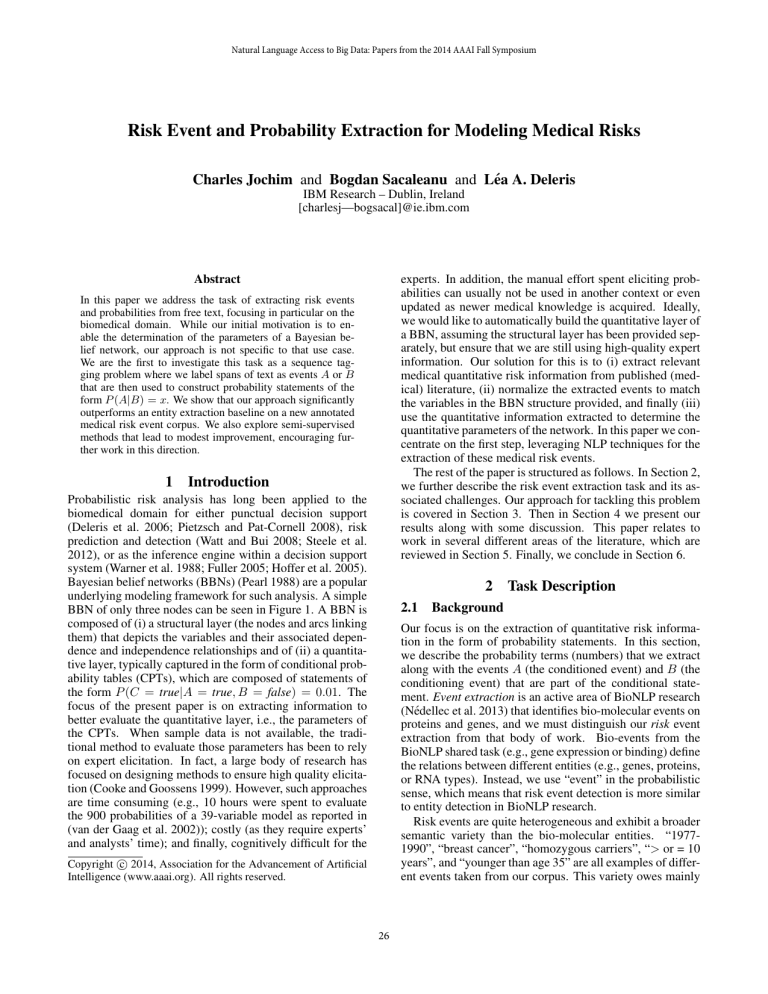
Natural Language Access to Big Data: Papers from the 2014 AAAI Fall Symposium
Risk Event and Probability Extraction for Modeling Medical Risks
Charles Jochim and Bogdan Sacaleanu and Léa A. Deleris
IBM Research – Dublin, Ireland
[charlesj—bogsacal]@ie.ibm.com
Abstract
experts. In addition, the manual effort spent eliciting probabilities can usually not be used in another context or even
updated as newer medical knowledge is acquired. Ideally,
we would like to automatically build the quantitative layer of
a BBN, assuming the structural layer has been provided separately, but ensure that we are still using high-quality expert
information. Our solution for this is to (i) extract relevant
medical quantitative risk information from published (medical) literature, (ii) normalize the extracted events to match
the variables in the BBN structure provided, and finally (iii)
use the quantitative information extracted to determine the
quantitative parameters of the network. In this paper we concentrate on the first step, leveraging NLP techniques for the
extraction of these medical risk events.
The rest of the paper is structured as follows. In Section 2,
we further describe the risk event extraction task and its associated challenges. Our approach for tackling this problem
is covered in Section 3. Then in Section 4 we present our
results along with some discussion. This paper relates to
work in several different areas of the literature, which are
reviewed in Section 5. Finally, we conclude in Section 6.
In this paper we address the task of extracting risk events
and probabilities from free text, focusing in particular on the
biomedical domain. While our initial motivation is to enable the determination of the parameters of a Bayesian belief network, our approach is not specific to that use case.
We are the first to investigate this task as a sequence tagging problem where we label spans of text as events A or B
that are then used to construct probability statements of the
form P (A|B) = x. We show that our approach significantly
outperforms an entity extraction baseline on a new annotated
medical risk event corpus. We also explore semi-supervised
methods that lead to modest improvement, encouraging further work in this direction.
1
Introduction
Probabilistic risk analysis has long been applied to the
biomedical domain for either punctual decision support
(Deleris et al. 2006; Pietzsch and Pat-Cornell 2008), risk
prediction and detection (Watt and Bui 2008; Steele et al.
2012), or as the inference engine within a decision support
system (Warner et al. 1988; Fuller 2005; Hoffer et al. 2005).
Bayesian belief networks (BBNs) (Pearl 1988) are a popular
underlying modeling framework for such analysis. A simple
BBN of only three nodes can be seen in Figure 1. A BBN is
composed of (i) a structural layer (the nodes and arcs linking
them) that depicts the variables and their associated dependence and independence relationships and of (ii) a quantitative layer, typically captured in the form of conditional probability tables (CPTs), which are composed of statements of
the form P (C = true|A = true, B = false) = 0.01. The
focus of the present paper is on extracting information to
better evaluate the quantitative layer, i.e., the parameters of
the CPTs. When sample data is not available, the traditional method to evaluate those parameters has been to rely
on expert elicitation. In fact, a large body of research has
focused on designing methods to ensure high quality elicitation (Cooke and Goossens 1999). However, such approaches
are time consuming (e.g., 10 hours were spent to evaluate
the 900 probabilities of a 39-variable model as reported in
(van der Gaag et al. 2002)); costly (as they require experts’
and analysts’ time); and finally, cognitively difficult for the
2
2.1
Task Description
Background
Our focus is on the extraction of quantitative risk information in the form of probability statements. In this section,
we describe the probability terms (numbers) that we extract
along with the events A (the conditioned event) and B (the
conditioning event) that are part of the conditional statement. Event extraction is an active area of BioNLP research
(Nédellec et al. 2013) that identifies bio-molecular events on
proteins and genes, and we must distinguish our risk event
extraction from that body of work. Bio-events from the
BioNLP shared task (e.g., gene expression or binding) define
the relations between different entities (e.g., genes, proteins,
or RNA types). Instead, we use “event” in the probabilistic
sense, which means that risk event detection is more similar
to entity detection in BioNLP research.
Risk events are quite heterogeneous and exhibit a broader
semantic variety than the bio-molecular entities. “19771990”, “breast cancer”, “homozygous carriers”, “> or = 10
years”, and “younger than age 35” are all examples of different events taken from our corpus. This variety owes mainly
Copyright c 2014, Association for the Advancement of Artificial
Intelligence (www.aaai.org). All rights reserved.
26
A
true
false
0.2
0.8
C
A
C
A
B
true
false
false
true
0.4
0.01
0.6
0.99
B
A
B
true
false
false
false
true
true
false
true
false
true
0.4
0.01
0.01
0.01
0.6
0.99
0.99
0.99
Figure 1: Example of Bayesian belief network with three variables
tify and extract the events A and B from text. Risk event
identification presents multiple challenges. Consider the example “Carriers of the AC haplotype, which represents the
variant alleles of both SNPs, were at an increased risk (OR =
1.41, 95% CI 1.09-1.82).” We have an odds ratio probability
term “OR = 1.41” and two events. However, determining
the boundaries of the events is not straightforward. Should
the conditioning event be the whole subject including the
relative clause, only “Carriers of the AC haplotype,” or even
simply “AC haplotype”? Another problem illustrated by this
example is that from this limited context we do not know
that “risk” refers to risk of breast cancer. Anaphora resolution should be added to the pipeline by linking “risk” to
“breast cancer” before construction of the BBN. This is left
for future work.
There are other problems not found in the above example.
In some cases one of the events may not be explicitly expressed in the sentence and must be inferred by the reader.
Finally, although it is usually clear to a human reader, it can
be challenging to determine automatically which is the conditioned event and which is the conditioning event. The distinction, however, is essential from a probability perspective,
as typically P (A|B) 6= P (B|A). Consider for instance the
case where A represents Winning the lottery and B represents Playing the lottery.
After identifying probability terms and extracting the related events, we can construct the conditional statements,
which after some post-processing will be used to evaluate
the parameters of a BBN. To better understand the task, we
annotated a corpus of probabilities and risk events. We cover
some details of how this corpus was created in the next section.
odds = P (A)/P (¬A)
Odds
P (A|B)
P (¬A|B)
P (A|¬B)
P (¬A|¬B)
Odds ratio
OR =
Relative risk
RR =
Hazard ratio
Population attributable risk
P (A|B)
P (A|¬B)
P (A(t)|B)
P (A(t)|¬B)
HR =
PAR = P (A|B) − P (A)
Table 1: Probability terms used in medical journals
to the fact that only the explicitly mentioned part of the event
has been annotated. We will need to develop new techniques
for detecting ellipses, metonymy, and anaphora resolution to
obtain more complete event definitions. In this initial work,
we focus on common risk events with a stronger signal in
the corpus, such as “disease-free survival” or “breast cancer
incidence”. Those will eventually constitute the variables
that appear in the BBN.
Probability expressions can take a number of forms. Even
the simplest probability statements can be complicated in
free text, represented as different combinations of words
and numbers, e.g., “Thirty-six percent”, “78.2 percent”,
“51.7%”, “5/1124”, or “51 out of 118”. Two of the most
common forms of probability statements are odds ratio (OR)
and relative risk (RR). In probability, the odds of an event is
defined as the probability that the event will occur divided
by the probability that the event will not occur. Odds ratios
are ratio of odds for different subgroups. For instance, if
we were to compare nulliparous women (no live birth) with
women having at least one live birth (mono/multiparous)
for the risk of developing breast cancer, then the odds ratio
would be:
OR =
2.2
P (breast cancer|nulliparous)
P (no breast cancer|nulliparous)
P (breast cancer|mono-/multiparous)
P (no breast cancer|mono-/multiparous)
Corpus
Our risk event probability corpus is comprised of 200 abstracts returned from PubMed that match the query “breast
cancer AND parity”. This follows in the tradition of other
biomedical corpora: GENIA (Kim et al. 2003), for example,
started as a set of abstracts from PubMed, which contained
the terms “human,” “blood cell,” and “transcription factor.”
Some statistics of the corpus can be seen in Table 2. Probability and event annotation was conducted in two rounds.
For the first round, three annotators independently annotated
each sentence in the corpus as a probability sentence or not
Table 1 summarizes some of the more common probability terms found in the medical literature and their equivalent probability equations. As in our example, variables
A, B, and ¬B (the complement of B) could be replaced
with values “breast cancer”, “nulliparous”, and “mono/multiparous” respectively.
Along with the probability terms we would like to iden-
27
Abstracts
Sentences
w/ events or probability
w/ event A
w/ event B
Avg. sentence/abstract
Avg. sentence length (tokens)
Avg. event/abstract
Avg. length event A (tokens)
Avg. length event B (tokens)
Avg. event A/prob. sentence
Avg. event B/prob. sentence
200
2045
376
315
316
10.2
37.9
4.5
2.3
2.3
1.1
1.3
word
lemma
POS tag
position
word shape
Table 3: Feature list. Features marked with an asterisk (*)
were extracted but did not improve classification and were
removed in feature selection.
3.2
(i.e., containing at least one probability expression) and then
for each probability sentence the events A and B were annotated. We measure inter-annotator agreement for probability
sentence detection by averaging Cohen’s kappa, κ = 0.920.
For the second round of annotation, a risk expert with experience assessing risk in the biomedical domain resolved annotation disagreements and corrected the event boundaries
when they differed between annotators. Although, the annotators are not experts in the biomedical domain, this type of
annotation does not require medical expertise. The goal of
the annotation is to identify events in a conditional statement
and this task is fairly domain independent. For instance, annotators can identify events A and B in “Average duration of
breast-feeding of 11-12 months reduced risk of breast cancer by 54% compared with the duration of 1-4 months” and
“At least 75 percent of all hydraulic systems fail due to contaminated or aging hydraulic fluid” without being experts in
either medicine or mechanical engineering.
3.1
Features
Our experiments use standard sequence tagging features
which are summarized in Table 3. We look at features at
different levels of linguistic complexity – from simple surface forms to dependence relations from a parse tree.
Features are extracted for each token, t, that is to be
tagged with the CRF. Our first features are simply the surface form of the word (wt ), lemma (lemmat ), and the partof-speech tag (post ). The word shape feature (shapet ) is
extracted using Stanford CoreNLP1 with the default word
shape algorithm similar to the one in Bikel et al. (1997).
We explored deeper linguistic features taken from
dependency-based parsing. For example, we use the arc label pointing to t and the POS tag of t’s head. Using the
dependency parse we also retrieve the predicate of the sentence and include a feature measuring the distance to the
predicate via dependency arcs. These features did not help
classification on the development set and are not included
in the experiments in Section 4. In preliminary experiments
we used a semantic feature – a UMLS tag – obtained via
MetaMap2 (Aronson 2001). This is a potentially useful feature but is expensive to extract (cf. Wang and Fan 2014),
and does not scale well with the semi-supervised solutions
we propose later in Section 4.1.
One of the advantages of using a sequence tagger
like CRF is that it utilizes the features from adjacent
tokens. The linear-chain CRF we use defines feature
templates for zeroth-order features and first-order features. Not all of the features listed above are effective as context features, and not all are useful as firstorder features. We start by looking at the following
context features: words (wt−2 , wt−1 , wt+1 , wt+2 ), lemmas (lemmat−2 , lemmat−1 , lemmat+1 , lemmat+2 ), part of
speech (post−2 , post−1 , post+1 , post+2 ), and word shape
(shapet−2 , shapet−1 , shapet+1 , shapet+2 ), and then use feature selection to choose the optimal amount of context to the
left and right for each feature.
Table 2: Risk Event Corpus statistics
3
dependency label*
head POS*
predicate*
distance to predicate*
Labeling Risk Events
Choice of Algorithm
Our goal is to accurately identify the probability terms and
events in conditional statements in medical texts. As we normalize event text before using them for probability aggregation, it is not highly critical to extract the exact boundary.
For example, it would still be acceptable in our system that
only “breast cancer” would be detected when the annotated
event is “development of breast cancer” (or vice versa).
We chose to explore whether sequence labeling could be
relevant for risk event identification. In particular we use
conditional random fields (CRF) (Lafferty, McCallum, and
Pereira 2001) which have been shown to work well for related NLP tasks (Sha and Pereira 2003; Settles 2004). We
use a linear-chain CRF defined as:
4
4.1
T X
X
1
P (y|x) =
exp(
θk fk (yt−1 , yt , xt ))
Zx
t=1
Results
Experimental Setup
We take all of the sentences which contain any event or probability annotation from the corpus described in Section 2.2.
This certainly is an idealized dataset containing only sentences with event and/or probability annotation, but we as-
k
where Zx normalizes over the entire input sequence (e.g.,
P
PT P
sentence), Zx =
y exp(
t=1
k θk fk (yt−1 , yt , xt )).
With a first-order CRF, features can be defined on the pair
of output tags yt−1 and yt .
1
2
28
http://nlp.stanford.edu/software/corenlp.shtml
http://metamap.nlm.nih.gov/
Algorithm 1 Self-training
L0 is labeled data, U0 is unlabeled data
µ ← train(L0 )
i←1
repeat
Li ← Li−1 + select(label(Ui−1 , µ))
Ui ← Ui−1 − select(label(Ui−1 , µ))
µ ← train(Li )
i←i+1
until stopping criterion is met
return µ
sume that we can accurately filter probability sentences.
In preliminary experiments we could reliably identify sentences as having a probability or not, using only bag-ofword features (achieving macro-F1 of 92.3 with a MaxEnt
model (Manning and Klein 2003)). The 376 probability sentences are divided into training, development, and test sets
(268/52/56 sentences respectively). To establish a baseline,
we borrow from the BioNLP/NLPBA 2004 shared task (Kim
et al. 2004). Specifically, all events found in the training
set are labeled as events in the test set. Then for our initial
fully-supervised classification we train a CRF on the labeled
training set.
We have chosen CRF++3 as the CRF implementation for
our experiments. We perform feature selection and parameter tuning on the development set. We start with feature
selection to determine which context features from positions t − 2 to t + 2 are beneficial and settle on the following features: wt−2 , wt−1 , wt , wt+1 , wt+2 , lemmat−1 ,
lemmat , post , shapet , shapet+1 , plus the CRF++ firstorder features (referred to as “bigram” features in CRF++)
bi-wt , bi-lemmat , bi-post . Because our dataset is rather
small, we need to restrict our feature set to avoid overfitting
(and improve run times). Using these context features and
the remaining features from Table 3, we fit the regularization
parameter, c, from {.5, .3, .1, 1, 3, 5}.
4.2
are likely to occur together in a probability statement. For
this threshold, first the unlabeled instance must be assigned
both events A and B and have a probability greater than 0.3
(P (y|x) > 0.3). Then we submit two queries to PubMed:
1) the text in event B (e.g., “anti-inflammatory drugs”), and
2) events A and B combined with the AND search operator (e.g., “anti-inflammatory drugs AND cancer”). We use
the number of hits returned from each of these queries to
estimate how likely it is that event A occurs given event B,
hits forA+B
P̂ (A|B) = PubMed
PubMed hits forB . If this estimate, P̂ (A|B), is
greater than 0.1, we add the instance to the labeled set, otherwise it remains in the unlabeled set. These are just a couple of a number of possible selection criteria and we aim to
explore better selection criteria in future work, along with
more sophisticated semi-supervised learning algorithms.
Self-training
Due to the facts that we have a relatively small labeled set
and there exists a wealth of unlabeled medical data (e.g., abstracts and articles from MEDLINE), we also want to explore semi-supervised approaches which can leverage the
vast amount of data available, and still be directed in a
way as to improve classification performance. We include
some initial experiments in this direction by employing a
standard semi-supervised learning approach, self-training.
Self-training is an iterative process that essentially labels instances from an unlabeled set and adds them to the labeled
set for the next iteration of model training. The risk of this
approach is that if incorrectly labeled instances are included
in the labeled set, the self-training will start going in the
wrong direction.
We start with a self-training algorithm similar to the one
described in (Abney 2007) (see Algorithm 1). The label
function is our CRF classification. Abney covers variations
of this basic self-training algorithm and covers a number of
the possible selection criteria. In this paper we try two different heuristic thresholds in the select function, which
chooses the instances to add to the labeled set, L. To start,
our unlabeled set is a sample of 5000 abstracts taken from
PubMed.
The first threshold (hereafter “self-training”) simply
checks if the unlabeled instance (i.e., sentence) has been assigned an event A or B and has probability output from the
CRF greater than 0.7, i.e., that P (y|x) > 0.7. The second threshold (hereafter “PubMed self-training”) relies on
PubMed. Our intuition is that we can use PubMed to provide additional support in deciding whether events A and B
4.3
Results are presented in Tables 4 and 5. They are calculated
using the conlleval Perl script4 and we report the precision, recall, and F1 score for individual tokens (Table 4) and
for phrases (Table 5). As mentioned previously, the exact
boundary is not as critical for our task as in other contexts
as the phrases “development of breast cancer”, “breast cancer”, and “breast cancer risk” should all be normalized to
the same node in our BBN model. Therefore, token-based
performance results are informative as well. However, it is
standard practice to measure entities or text chunks by F1 ,
despite its drawbacks,5 which is why we include those results. As can be seen in Table 4, the baseline that we have
chosen has good precision and weaker recall. It takes events
from the training data that are likely to also be events in the
development set. Naturally, events not seen in training will
not be labeled, lowering recall.
The CRF method outperforms the baseline with higher
overall F1 . Considering the token-based results in Table 4,
recall for both events A and B exceeds the baseline, while
CRF precision only improves for event A. We test statistical significance of overall F1 , and F1 for each event, using
approximate randomization (Noreen 1989). F1 differences
overall and for event A are significant, but there is no significant difference for event B. The overall results are much
4
http://www.cnts.ua.ac.be/conll2000/chunking/conlleval.txt
http://nlpers.blogspot.com/2006/08/doing-named-entityrecognition-dont.html
5
3
Development Results
http://crfpp.googlecode.com/svn/trunk/doc/index.html
29
Baseline
Pre. Rec. F1
Event A
51.9 30.2 38.1
Event B
51.7 25.0 33.7
Prob. term 41.2 35.8 38.3
Overall
46.9 30.5 37.0
Pre.
53.4
37.5
93.4
64.0
CRF
Rec.
46.3
32.5
92.7
58.3
Self-training
Pre. Rec. F1
Event A
51.6 46.3 48.8
Event B
40.0 33.3 36.4
Prob. term 92.0 92.7 92.4
Overall
63.9 58.5 61.1
PubMed self-training
Pre. Rec.
F1
50.9 43.4
46.8
46.2 30.0
36.4
94.7 90.5
92.5
67.4 55.7
61.0
F1
49.6
34.8
93.0
61.0
Baseline
Pre. Rec. F1
Event A
23.2 22.0 22.6
Event B
41.8 36.5 39.0
Prob. term 39.4 34.2 36.6
Overall
35.2 31.4 33.2
Pre.
58.3
42.5
91.4
71.3
CRF
Rec.
35.6
27.0
90.2
54.9
Self-training
Pre. Rec. F1
Event A
48.8 35.6 41.2
Event B
47.2 27.0 34.3
Prob. term 91.4 90.2 90.8
Overall
70.0 54.9 61.5
PubMed self-training
Pre. Rec.
F1
53.9 35.6
42.9
41.0 25.4
31.4
91.3 89.0
90.1
69.6 53.9
60.8
F1
44.2
33.0
90.8
62.1
Table 4: Token-based results on development set
Table 5: Phrase-based results on development set
higher than the baseline due to the performance of probability term extraction, but we are more interested in the performance for events A and B.6
The baseline approach tends to find more, but shorter
phrases than the CRF: the baseline has 56 event A phrases
with an average length of 1.41 words and 55 event B phrases
with an average length of 1.05 words, while the CRF has 32
event A phrases with an average length of 2.53 words and
38 event B phrases with an average length of 2.29 words.
Because of this, the event B phrase baseline performs quite
well. Most of the event B true positives are single words;
12 of the 23 true positives come from the phrase “women”
which frequently occurs as an event B. If the event B labeled by the CRF is “British women” this counts as a false
positive and false negative with no partial credit for identifying “women”.
We ran self-training and PubMed self-training for three iterations because scores began to drop on the third iteration.
We report the results after the second iteration, which are the
best for both self-training and PubMed self-training. The
overall token-based F1 results for self-training are slightly
better than fully-supervised CRF, and the PubMed selftraining results do just as well as fully-supervised CRF.
These results are modest, but promising. Self-training runs
the risk of decreasing performance and has led to negative
results in other domains, so these improvements are very encouraging and will push us to improve our selection criteria
to get further improvements.
instead of B or vice versa). A few of these errors involve
tricky cases with adjectives that are not consistently annotated as part of an event. An example error that illustrates
4.4
A
this is the following: (i) “... being current drinkers ...” (from
A
the training corpus) and (ii) “of current HER2 testing may
A
...” (gold labels above with superscript and classifier labels
below with subscript; no annotation means it has the label
“O”). In (i), “current” is part of event A, while in (ii) it is
not. There are similar errors for other adjectives and also
past tense verbs that can have the tags VBD or VBN. For
example, “improved” can be simple past (VBD) or a past
participle (VBN); in the latter case it often acts as an adjective.
Although these boundary errors doubly penalize F1 –
counting as both a false positive and false negative – they occur relatively infrequently for our task, and will likely have
little negative impact in our overall system, which would
cluster “current drinkers” and “drinkers” when necessary.
There were only three phrases which mislabeled A instead
of B and vice versa, and all three contribute to the above
errors in boundary detection.
Overall, the majority of the errors involve missing entire
phrases. There are 75 event A and B phrases that are not
tagged at all (i.e., have label “O”) and only 29 phrases which
should not be tagged, but have some label A or B. These are
the errors we plan to tackle in future work, in particular the
high number of false negatives. One solution for this might
be to use another classifier with higher recall and stack our
CRF model on top using the high-recall classifier output as
a new feature. Another option would be to constrain probability sentences to have variables A and B since most errors
come from the lack of event A and B labels in the classification and not the misclassification of these events.
Error Analysis
We initially argued for measuring F1 on tokens (Table 4)
along with phrases (Table 5) because exact boundaries are
less critical for our task. However, looking more closely at
the phrase results, the CRF performs well in terms of identifying the correct boundaries. Only 12 of the 204 phrases
in the development set had incorrectly labeled boundaries,
and of those, four also had erroneous event labels (e.g., A
4.5
Test Results
We see similar results for the test data. Scores from CRF
classification are actually higher for the test set indicating
that we did not tune the algorithm to perform well only
6
We also tested some regular expressions to capture the probability term but the F1 results were similar to those from this baseline, so we use only this baseline for simplicity.
30
Baseline
Rec.
27.8
27.2
33.1
29.3
Event A
Event B
Prob. term
Overall
Pre.
49.5
60.6
38.3
47.3
F1
35.6
37.6
35.5
36.2
Event A
Event B
Prob. term
Overall
Self-training
Pre. Rec. F1
64.8 46.8 54.3
63.5 38.6 48.0
100.0 85.1 92.0
77.3 56.0 65.0
CRF
Pre. Rec.
69.6 47.3
60.6 38.0
100.0 84.5
78.2 55.8
F1
56.3
46.7
91.6
65.1
PubMed self-training
Pre. Rec.
F1
65.2 44.4 52.8
58.4 41.8 48.7
99.2 85.1 91.6
75.2 56.2 64.3
Baseline
Rec.
21.9
21.8
30.0
25.2
Event A
Event B
Prob. term
Overall
Pre.
22.6
27.0
41.1
30.8
F1
22.2
24.1
34.7
27.7
Event A
Event B
Prob. term
Overall
Self-training
Pre. Rec. F1
52.4 34.4 41.5
61.0 32.1 42.0
100.0 78.0 87.6
77.6 51.7 62.0
CRF
Pre. Rec.
53.9 32.8
61.5 30.8
100.0 78.0
78.9 50.8
F1
40.8
41.0
87.6
61.8
PubMed self-training
Pre. Rec.
F1
53.5 35.9 43.0
60.0 34.6 43.9
100.0 77.0 87.0
77.0 52.5 62.4
Table 6: Token-based results on test set
Table 7: Phrase-based results on test set
on the development data. Self-training and PubMed selftraining were run for two iterations like for the development
set. CRF, self-training, and PubMed self-training all significantly improve over the baseline for overall F1 , as well
as for event A and B (using approximate randomization).
These three do not significantly differ from each other. Like
in the development set, F1 increases for event B and drops
for event A.
There has been previous work that builds Bayesian networks from medical data, however, none extracts conditional probability statements for building BBNs as we do.
Sanchez-Graillet and Poesio (2004) build Bayesian networks by focusing on causal relations. Their approach
relies on a fixed list of causal relation patterns (from
Girju and Moldovan (2002)) that they use for extracting
(cause,connective,effect) tuples. The conditional probabilities are estimated using maximum likelihood estimation
(MLE) on these tuples and not on the whole dataset. Similarly, Theobald, Shah, and Shrager (2009) use MLE for
estimating probabilities but use co-occurrence information
from a much larger dataset. This approach for extracting conditional probabilities from the medical text is simple, requiring no real linguistic processing. They simply count the co-occurrences of treatments, diseases, and
genes in PubMed data for constructing conditional statements of the form P (treatment|disease, gene). In other
words, both approaches assume that probabilities are related
to co-occurrences in some specific patterns. While practical, and possibly leading to meaningful results, it is slightly
troubling to think that, for instance, the probability of developing breast cancer given a person is a man8 is estimated
by counting the ratio of times both terms are present in the
same sentence of a chosen set of texts. Corpus selection
thus would play a large role in probability estimation. In
addition, this would mean that when an author in a medical
paper seeks to clarify a point by rephrasing a sentence, he
may influence the probability estimation. As presented in
this paper, we have chosen a different approach where we
seek to extract only explicit probability statements.
5
Related Work
BioNLP event extraction (Kim et al. 2009; Nédellec et al.
2013) is similar to our probability extraction in that it extracts entities, analogous to our probabilistic events A and
B, and the relations between entities, i.e., bio-molecular
events. Instead, we extract conditional probability relations
that include a probability term (see Section 2). In the most
recent BioNLP shared task, Björne and Salakoski (2013)
achieved the best results for 6 of the 10 tasks, including event
extraction. They use a chain of SVM classifiers to detect,
e.g., entities, relations, speculation, and negation. We use
CRFs to globally optimize labels in the sentence and avoid
cascading errors using a chain of classifiers, however, we
have not yet been able to try our approach on the GENIA
event extraction corpus.
Fiszman et al. (2007) are also interested in extracting risk
factors and diseases7 from medical literature, but differ from
us in their approach. They convert the biomedical text into
a semantic representation, using the UMLS Semantic Network, and define a set of rules which identify risks and disorders based on the semantic expression. Their approach
requires considerable effort and expertise in defining and
crafting the semantic rules, however, it could be beneficial
to bootstrap our statistical approach using their risks and disorders. In fact, Abacha and Zweigenbaum (2011) conclude
that such a combination of statistical approaches with medical domain knowledge sources leads to better results. Their
approach is similar to ours, using a CRF with medical features from MetaMap, but the task differs.
6
Conclusions
In this paper, we describe a model for extracting conditional
probability statements, in the form of P (A|B) = x from
medical texts. This is a difficult task due to the wide variety
of forms a conditioned event A and conditioning event B can
take. Nonetheless, a satisfactory solution to this problem
7
Risks and disorders are subsets of events A and B, but do make
up a significant part of each.
8
Men can develop breast cancer though incidence is lower than
for women.
31
Fiszman, M.; Rosemblat, G.; Ahlers, C. B.; and Rindflesch,
T. C. 2007. Identifying risk factors for metabolic syndrome
in biomedical text. In Proceedings of the AMIA Annual Symposium, 249–253.
Fuller, G. 2005. Simulconsult: www.simulconsult.com.
Journal of Neurology, Neurosurgery & Psychiatry
76(10):1439–1439.
Girju, R., and Moldovan, D. I. 2002. Text mining for causal
relations. In FLAIRS Conference, 360–364.
Hoffer, E. P.; Feldman, M. J.; Kim, R. J.; Famiglietti, K. T.;
and Barnett, G. O. 2005. DXplain: patterns of use of a mature expert system. AMIA Annual Symposium Proceedings
2005:321–324. PMID: 16779054 PMCID: PMC1560464.
Kim, J.-D.; Ohta, T.; Tateisi, Y.; and Tsujii, J. 2003. GENIA
corpus–a semantically annotated corpus for bio-textmining.
Bioinformatics 19(suppl 1):i180–i182.
Kim, J.-D.; Ohta, T.; Tsuruoka, Y.; Tateisi, Y.; and Collier,
N. 2004. Introduction to the bio-entity recognition task at
JNLPBA. In Proceedings of the International Joint Workshop on Natural Language Processing in Biomedicine and
Its Applications, JNLPBA ’04, 70–75. Stroudsburg, PA,
USA: Association for Computational Linguistics.
Kim, J.-D.; Ohta, T.; Pyysalo, S.; Kano, Y.; and Tsujii, J.
2009. Overview of BioNLP’09 shared task on event extraction. In Proceedings of the BioNLP 2009 Workshop Companion Volume for Shared Task, 1–9. Boulder, Colorado:
Association for Computational Linguistics.
Lafferty, J. D.; McCallum, A.; and Pereira, F. C. N. 2001.
Conditional random fields: Probabilistic models for segmenting and labeling sequence data. In Proceedings of the
Eighteenth International Conference on Machine Learning,
ICML ’01, 282–289. San Francisco, CA, USA: Morgan
Kaufmann Publishers Inc.
Manning, C. D., and Klein, D. 2003. Optimization, maxent models, and conditional estimation without magic. In
Proceedings of HLT-NAACL, 8.
Nédellec, C.; Bossy, R.; Kim, J.-D.; Kim, J.-J.; Ohta, T.;
Pyysalo, S.; and Zweigenbaum, P. 2013. Overview of
BioNLP shared task 2013. In Proceedings of the BioNLP
Shared Task 2013 Workshop, 1–7. Sofia, Bulgaria: Association for Computational Linguistics.
Noreen, E. 1989. Computer-intensive methods for testing
hypotheses: An introduction. Wiley.
Pearl, J. 1988. Probabilistic Reasoning in Intelligent Systems: Networks of Plausible Inference. San Francisco, CA,
USA: Morgan Kaufmann Publishers Inc.
Pietzsch, J. B., and Pat-Cornell, M. E. 2008. Early technology assessment of new medical devices. International
Journal of Technology Assessment in Health Care 24:36–44.
Roth, D., and Yih, W. 2007. Global inference for entity and
relation identification via a linear programming formulation.
In Getoor, L., and Taskar, B., eds., Introduction to Statistical
Relational Learning. MIT Press.
Sanchez-Graillet, O., and Poesio, M. 2004. Acquiring
Bayesian networks from text. In LREC.
would prove useful, not only to generate input to simplify
the process of building Bayesian belief networks for health
risk analysis, but also to be able to automatically extract and
synthesize probabilistic statements made in a given corpus.
The automation of the process makes it possible to perform
the analysis over time and identify trends. In addition, other
domains, such as finance, auditing, and maintenance, could
find time-saving benefits of automatic probability extraction.
Our proposed approach, based on CRFs, improves over
an established baseline and shows that this task is better
handled as a sequence tagging problem. Using standard sequence tagging features we are able to identify events A and
B as well as probability terms. We also got small improvements from using self-training, which we intend to build
upon with better selection criteria.
There are a number of other improvements that can be
made to reliably use the extracted probability terms and risk
events to generate a BBN for a given disease. We would like
to look at other semi-supervised approaches to access larger
amounts of unlabeled medical data. We also plan to test
integer linear programming (ILP) for adding additional constraints to our models (Roth and Yih 2007). Finally, we will
explore whether hybrid methods, i.e., those involving both
expert knowledge and NLP algorithms can provide further
improvements.
Acknowledgments
This project was supported in part through a grant from the
Irish Innovation Development Agency (reference 133954,
September 2009).
References
Abacha, A. B., and Zweigenbaum, P. 2011. Medical entity
recognition: A comparison of semantic and statistical methods. In Proceedings of BioNLP 2011 Workshop, 56–64.
Abney, S. 2007. Semisupervised Learning for Computational Linguistics. Chapman and Hall/CRC Press.
Aronson, A. R. 2001. Effective mapping of biomedical text
to the UMLS metathesaurus: the MetaMap program. In Proceedings of AMIA, Annual Symposium, 17–21.
Bikel, D. M.; Miller, S.; Schwartz, R.; and Weischedel, R.
1997. Nymble: a high-performance learning name-finder.
In Proceedings of the Fifth Conference on Applied Natural Language Processing, 194–201. Washington, DC, USA:
Association for Computational Linguistics.
Björne, J., and Salakoski, T. 2013. TEES 2.1: Automated
annotation scheme learning in the BioNLP 2013 shared task.
In Proceedings of the BioNLP Shared Task 2013 Workshop,
16–25. Sofia, Bulgaria: Association for Computational Linguistics.
Cooke, R., and Goossens, L. 1999. Procedures guide for
structured expert judgment. Technical Report EUR18820,
Brussels-Luxembourg: Commission of the European Communities.
Deleris, L. A.; Yeo, G. L.; Seiver, A.; and Paté-Cornell,
M. E. 2006. Engineering risk analysis of a hospital oxygen
supply system. Medical Decision Making 26(2):162–172.
32
Settles, B. 2004. Biomedical named entity recognition
using conditional random fields and rich feature sets. In
Proceedings of the International Joint Workshop on Natural
Language Processing in Biomedicine and Its Applications,
JNLPBA ’04, 104–107. Stroudsburg, PA, USA: Association
for Computational Linguistics.
Sha, F., and Pereira, F. 2003. Shallow parsing with conditional random fields. In Proceedings of the 2003 Conference of the North American Chapter of the Association for
Computational Linguistics on Human Language Technology
- Volume 1, NAACL ’03, 134–141. Stroudsburg, PA, USA:
Association for Computational Linguistics.
Steele, S.; Bilchik, A.; Eberhardt, J.; Kalina, P.; Nissan, A.;
Johnson, E.; Avital, I.; and Stojadinovic, A. 2012. Using
machine-learned Bayesian belief networks to predict perioperative risk of clostridium difficile infection following colon
surgery. Interact J Med Res 1(2):e6.
Theobald, M.; Shah, N.; and Shrager, J. 2009. Extraction of
conditional probabilities of the relationships between drugs,
diseases, and genes from PubMed guided by relationships in
PharmGKB. In 2009 AMIA Summit on Translational Bioinformatics, 124–128. Grand Hyatt, San Francisco: American
Medical Informatics Association.
van der Gaag, L. C.; Renooij, S.; Witteman, C.; Aleman,
B. M.; and Taal, B. G. 2002. Probabilities for a probabilistic network: a case study in oesophageal cancer. Artificial
Intelligence in medicine 25(2):123–148.
Wang, C., and Fan, J. 2014. Medical relation extraction with
manifold models. In Proceedings of the 52nd Annual Meeting of the Association for Computational Linguistics (Volume 1: Long Papers), 828–838. Baltimore, Maryland: Association for Computational Linguistics.
Warner, H.; Haug, P.; Bouhaddou, O.; Lincoln, M.; Sorenson, D.; Williamson, J.; and Fan, C. 1988. Iliad as an expert
consultant to teach differential diagnosis. In Proceedings of
the 12th Symposium on Computer Applications in Medical
Care (SCAMC), IEEE Computer Society Press, 371–376.
Watt, E. W., and Bui, A. A. 2008. Evaluation of a dynamic Bayesian belief network to predict osteoarthritic knee
pain using data from the osteoarthritis initiative. AMIA Annu
Symp Proc 788–792.
33
